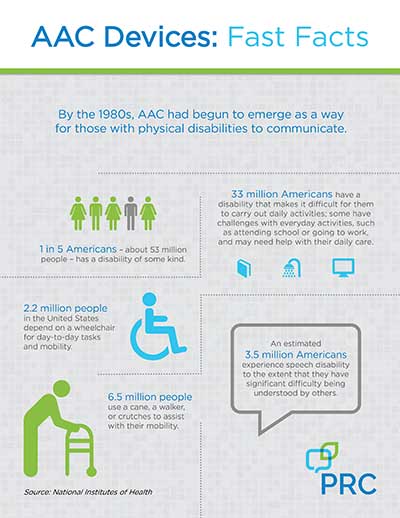 October is AAC Awareness Month
October is AAC Awareness Month
Join PRC as we celebrate AAC Awareness Month! Follow us throughout October and read stories from individuals and their families who use an AAC device, find helpful resources, download infographics and learn interesting facts.
On Twitter, look for our hashtags: #AACAwarenessMonth #AACandPRC
Everyone has something to say. For those who cannot speak, AAC gives them their voice.
What is Augmentative & Alternative Communication?
AAC is an umbrella term for communication methods. This includes anything someone may use to express themselves, from unaided communication that uses no equipment such as sign language, gestures and picture boards to aided communication that uses external tools such as mobile device apps and sophisticated, dedicated speech-generating devices (SGDs).
Whether someone is an aided or unaided communicator depends on his or her own unique set of circumstances. Thus, AAC can be used briefly (in the instance of someone who has suffered a stroke and is expected to eventually regain speech) or throughout the duration of their lifetime (those with cerebral palsy, autism, Rett Syndrome, traumatic brain injury, etc.)
What is an SGD?
Speech-generating devices produce electronic voice output. The communicator selects the letters, words and messages, alone or in combination, to be spoken aloud in a pre-recorded or computer-generated voice (text-to-speech).
Again, depending on the communicator, if selecting keys via touch isn't possible access to the device may be dependent on external aids including eye gaze, head pointing, joysticks, switches or even a combination of these.
Timeline
A (very brief!) timeline on the history of augmentative and alternative communication.
| 16th Century |
Manual alphabets and signs are widely used throughout Europe. In North America, Native Americans use a gestural system, Hand Talk, to facilitate communication between tribes. |
| 1920s: |
The first widely available communication aid, a letter and word-based board, was developed by and for F. Hall Roe, who had cerebral palsy. |
| 1950s: |
Awareness of the needs of individuals with communication and other disabilities begins to grow, ushering in the modern era of AAC, with manual signs, communication boards and Morse code the primary methods used. |
| 1960s: |
In the U.K., Reg Maling creates a sip-and-puff typewriter controller named POSSUM (patient-operated selector mechanism), ushering in the era of electronic communication aids. |
| 1966: |
Barry Romich and Ed Prentke meet and form Prentke Romich Company (PRC). |
| 1969: |
PRC produces its first communication device, a typing system based on a discarded Teletype machine. |
| 1970: |
Researchers at Delft University in the Netherlands crate the LOT (lightspot operated typewriter), which uses head movement to point a small spot of light at a matrix of characters. |
| 1971: |
Keyboard communication devices are developed in Denmark, the Netherlands and the U.S., increasing device portability. |
| 1980s: |
Technology advances lead to more devices along with reducing size and price. Screen scanning becomes widely available. Eye gaze is introduced. Digitized and synthesized speech output becomes more common. |
| 1982: |
Prentke Romich teams with Bruce Baker of SEMANTIC COMPACTION to incorporate the MINSPEAK vocabulary in PRC devices. |
Did You Know...
 The first electronic communication aid was a sip-and-puff typewriter controller prototyped in 1960 by Reg Mailing of the U.K. Named POSSUM, for "patient operated selector mechanism," the device scanned through a set of symbols on an illuminated display.
The first electronic communication aid was a sip-and-puff typewriter controller prototyped in 1960 by Reg Mailing of the U.K. Named POSSUM, for "patient operated selector mechanism," the device scanned through a set of symbols on an illuminated display.
 In 1970, researchers at Delft University in the Netherlands created the first use of head pointing technology with the LOT, or "lightspot operated typewriter."
In 1970, researchers at Delft University in the Netherlands created the first use of head pointing technology with the LOT, or "lightspot operated typewriter."
 Author, painter and poet Christy Brown (1932-1981), the subject of the book and movie My Left Foot, was born with cerebral palsy. Despite this, he went on to write nine books and paint using his left foot (hence his autobiographical title) and achieved international notoriety.
Author, painter and poet Christy Brown (1932-1981), the subject of the book and movie My Left Foot, was born with cerebral palsy. Despite this, he went on to write nine books and paint using his left foot (hence his autobiographical title) and achieved international notoriety.
AAC & Autism Webinar
A webinar with Lance McLemore on AAC and Autism. Lance is an adult with autism who shared his story, offered advice to families about using AAC at home and answered questions from the audience. This is worth a watch, or rewatch!
AAC Stories
They're funny, sad, touching...but all of them are stories of those who use AAC to express themselves.
Meet our device users, who aren't afraid to tell the world who they are!
Infographics
Download our infographics
|

Click the image to download a full-size graphic.
|

Click the image to download a full-size graphic.
|

Click the image to download a full-size graphic.
|

















 October is AAC Awareness Month
October is AAC Awareness Month The first electronic communication aid was a sip-and-puff typewriter controller prototyped in 1960 by Reg Mailing of the U.K. Named POSSUM, for "patient operated selector mechanism," the device scanned through a set of symbols on an illuminated display.
The first electronic communication aid was a sip-and-puff typewriter controller prototyped in 1960 by Reg Mailing of the U.K. Named POSSUM, for "patient operated selector mechanism," the device scanned through a set of symbols on an illuminated display.


